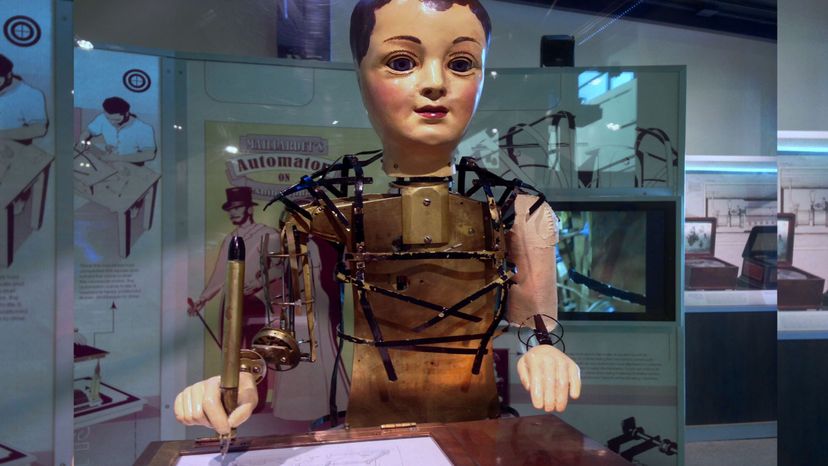
In the 21st century, we've become almost accustomed to the idea ofrobotsbeing able to duplicate and even exceed human feats of agility and dexterity. They're not only doing jobs such as building automobiles and working in e-commerce warehouses, they're alsodancing to rock and roll musicand eventaking up the sport of parkour.
But actually, the idea of automata —human-like machinesdesigned to imitate human abilities — actually dates back thousands of years. The word automaton is derived from the ancient Greek wordautomatos,which means self-acting, and the Greeks built some of the earliest machines that emulated living creatures, from mechanical dolphins and eagles that entertained crowds at the Olympic Games to a mechanicalpuppettheater, as this 2018Nature articledescribes.
In Renaissance Europe, churchgoers marveled at mechanized angels. In 1495, Leonardo da Vinci designed a robotic knight that could move its limbs, though it's not clear whether he actually built it, according to Allison Lee Palmer's book"Leonardo da Vinci: A Reference Guide to His Life and Works."
Advertisement
Maillardet's Automaton Is Born
In the early 19th century, a particularly marvelous human-like machine reached new heights of complexity, and even mimicked humans' artistic self-expression. We're referring toMaillardet's Automaton, adevicecreated around 1800 by Swiss mechanical designer Henri Maillardet, who worked in London building clocks and other machines. The automaton, which resembles a human boy sitting a table with pen in hand, is capable of making four different drawings and even writing out three poems — two in French and one in English.
"The significance of the Maillardet Automaton is that it has one of the largest working memories of any existing automaton from the same time period," explainsSusannah Carrollvia email. She's assistant director of collections and curatorial at theFranklin Institutein Philadelphia, one of the nation's foremost science and technology education centers, which acquired the automaton from the estate of a wealthy Philadelphian back in 1928, and spent decades restoring and maintaining it.
By memory, she's not talking about computer chips. Instead, the memory of Maillardet's Automaton is in the form of brass disks called cams, that are turned by a clockwork motor. Three steel fingers follow the cams' irregular edges, and translate the cams' movements into side-to-side, front-and-back and up-and-down movements of the automaton's writing hand, by means of an even more complicated system of levers and rods. Here's a YouTube video of the automaton at work:
“虽然自动化机器,甚至人类的machines were written about and probably even created thousands of years ago, automata of this size were not common at all," Carroll says. The Maillardet Automaton was an engineering accomplishment and continues to be an impressive wonder of machinery and skill. I would define it as an example of the apex of a type of automation with limitations defined by the time period in which it was made."
Unlike the larger humanoid machines created in the Renaissance, which were powered by water displacement or pulley systems, most of the automata of the period in which Maillardet worked were just a few inches in size, with miniature clockwork mechanisms designed to replicate animals such as birds and frogs. Even so, creating the small, intricate devices was a complex task.
"Sometimes a single automaton would be created by workshops in different countries," Carroll says. "For example, the mechanism may be made in Switzerland, the enameling or gilding may be done in France, and then the automaton would be sold in England." Records are rare for the automata that remain in existence, so that it can be a challenge to figure out who built them. The Franklin Institute, though, didn't face that problem, since Maillardet's Automaton signs the last of his four drawings "by the Automaton of Maillardet."
Advertisement
The Apprenticeship of Henri Maillardet
Maillardet himself learned how to build human-like machines as an apprentice of Pierre Jaquet-Droz, an 18th-century Swiss clockmaker and watchmaker and master mechanic. As Lisa Nocks details in her book "The Robot: The Life Story of a Technology,“Jaquet-Droz联合国successfully to gain the king of Spain as his patron, but instead was imprisoned by the Spanish Inquisition for several years before returning to Switzerland. Jacquet-Droz's shop produced several impressive automatons, including the replica of a 3-year-old child sitting on a stool that wrote on a small desk with a feather quill. several of Jaquet-Droz's automata that areon displayin the Musée d'Art et d'Histoire in Neuchâtel, Switzerland.
When Maillardet struck out on his own and opened his own workshop in London, he pushed the art and science of building automatons even further. "It probably would have taken three craftspeople around two years to design and construct an automaton like the one in our collection," Carroll says. "Skills in watch and clock-making would be instrumental in constructing an automaton. Metalsmithing, material science, precision, creativity, patience, all would likely play a role."
Like those machines, Maillardet's Automaton was designed primarily to amaze and entertain audiences at exhibitions, according to Carroll. "Replicating life has always been an interesting endeavor," she says. "It is an ultimate challenge for the machinist and forces the viewer question what it means to be human, similar to humanoid robots today."
Maillardet and other watch and clockmakers would travel their large automatons — like the one in the Franklin Institute's collection — to create an experience that would make a powerful impression upon spectators, most of whom had never seen sophisticated mechanical technology. "In the 1700s, people were still looking at the town hall or church clock (which may have had automata like the Strasbourg Astronomical Clock) to see the time," Carroll explains. "Pocket watches were not yet widely worn by the general public, so you can imagine it would be rare to have an automaton in your personal collection."
Maillardet toured Europe with the automaton until his death in 1830, reaching as far east as Russia. After that, the machine's history becomes sketchy. According to the Franklin Institute's website, it's possible that circus impresario P. T. Barnum acquired the device and put it on display in his museums in New York City and Philadelphia. The device may have been damaged in one of the fires that destroyed both museums, before it somehow came into the possession of the Brock family in Philadelphia.
Though automata — such as the mechanical fortunetellers at amusement parks — continued to be popular entertainment into the 1900s, the fascination with them gradually faded a bit. Carroll suspects that even more spectacular, world-changing technologies that emerged during the 1990s, from airplanes to television, may have automata seem less novel.
"Maybe there were so many advances in storing data — like the Maillardet Automaton's seven programs to what we have now — that we just leapt from mechanical to our computerized robots," she says.
Advertisement





